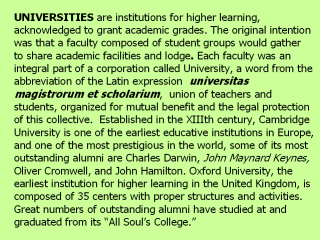 |
The first University was founded in
Bologna in the early XIIth century, and the second one in Paris by the end
of the same century. By 1300, there were already 16 universities existing in
Italy, France, England and Spain. By the XIVth century, 30 more were added
including in Austria, Poland and Bohemia. By 1500, there were as many as 60
universities. The University granted a “Licentia Docenti” as a
teachers’ union, which was an authorization to teach that intended: the
understanding of the classics and argumentative capacity. At some
universities such as the one in Salamanca, whose model would be
implemented in Latin America, the vision of the medieval world prevailed
associated with the predominance of the Catholic Church’s conceptions which
were widely promoted. Meanwhile, other universities such as in Oxford
in England, openly stimulated modernizing concepts developed by
intellectuals such as Francis Bacon, where the inductive method was
acknowledged as the way to scientific knowledge. Those institutions opened
spaces to new content for teachings, including skills for agriculture,
industry and commerce. The universities redefined their mission and purpose,
or returned to earlier conceptions, resulting in a history full of irony and
ambiguity, overrun with and the resetting of ideals lost and recovered. To
understand that history requires that we recount how the universities had
faced the classes or specific categories of educational types and levels:
Liberal Arts, Professions, Science, Technology, Research and Vocation. |
